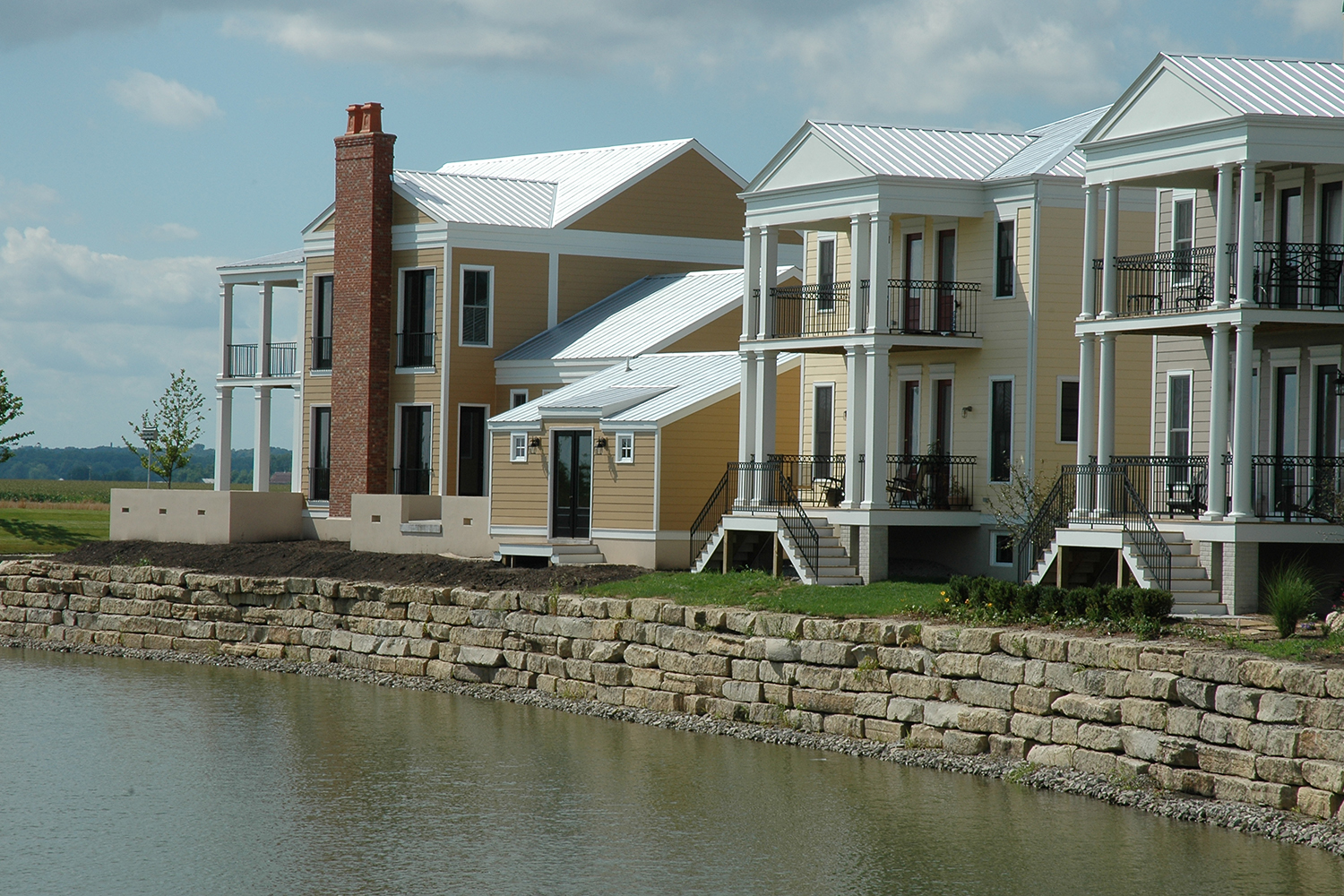
America is a place defined by bigness. It is infamous, both within its borders and abroad, for the size of its cars, its portions, its defense budget—and its houses.
Rightly so: U.S. houses are among the biggest—if not the biggest—in the world. According to the real-estate firms Zillow and Redfin, the median size of an American single-family home is in the neighborhood of 1,600 or 1,650 square feet. About five years ago, Sonia A. Hirt, a professor of landscape architecture and planning at the University of Georgia, was working on a book about land-use patterns in the U.S., and when she tracked down the average size of dwellings for about two dozen countries, the U.S. came out on top. Her comparisons were rough because she’d cobbled together her data from various sources, but she found that American living spaces had a good 600 to 800 square feet on most of the competition.
Looking just at the average size of newly built houses—as opposed to an average for all houses in a country, which is a smaller number—Australia, Canada, and New Zealand are on par with the U.S.; the averages for new houses in these countries approach or exceed 2,000 square feet. These same four countries have the most rooms per household occupant of 40 mostly wealthy countries studied by the Organization for Economic Cooperation and Development.
These data on house sizes come with a number of caveats: Different countries lump houses into different categories—Denmark, for instance, tracks the sizes of “cottages” in addition to those of other residential structures, and Redfin’s and Zillow’s figures vary based on whether they account for townhouses, condos, and the like. Some countries include only people’s primary residences in their analyses. And comparisons get further muddled by the fact that different countries have different levels of urbanization and density.
But that variance in density, in a way, is the point: Even in the absence of a uniform, universal system of measurement, America is in the top tier, globally, when it comes to the size of its citizens’ living spaces. The country attained this status in the past half century or so as a result of its peculiar history, culture, and economics.
It’s not that the U.S. has large houses because it has more land than other countries do. “People intuitively often think that this is the explanation … because America is such a big country,” Hirt told me. “Well, this is true, but Russia is a big country. Kazakhstan is a big country. Space itself doesn’t really make people do one thing or another.”
Government policies, however, do. As Hirt explains in her book Zoned in the USA: The Origins and Implications of American Land-Use Regulation, the dictates of government have for the past century effectively steered Americans toward living in detached single-family homes—the formal term for a prototypical stand-alone house with a yard.
“[A] nation of homeowners, of people who own a real share in their own land, is unconquerable,” Franklin D. Roosevelt said in 1942. Of course, it doesn’t necessarily follow that a nation of homeowners must own big houses, but a slew of policies—from the creation of the Federal Housing Administration in 1934 to the zoning mandates of individual towns and cities—fueled the growth of suburbs, and in turn the growth of the houses of which they were composed.
Many houses in postwar suburbs—such as those in the famous preplanned Levittowns—were actually quite modest, at roughly 850 square feet, says Dolores Hayden, a former professor of architecture and American studies at Yale. But over the course of the 20th century, government policy, the invention of cheaper, mass-produced building materials, marketing by home builders, and a shift in how people regarded their houses—not just as homes, but as financial assets—encouraged ever larger houses.
In the realm of house sizes, Europe is a common point of comparison to the United States, because things have played out very differently in the two regions (and because comprehensive data on house sizes in other parts of the world is harder to come by). One key difference is that America’s period of suburban expansion (which, it’s worth noting, largely excluded whole categories of Americans) coincided with the uptake of the automobile and the development of a more connected network of highways. Being able to drive farther from a city center meant cheaper land, which meant more space and bigger houses. “Partially why the Europeans really cannot yet reach—if that’s a good thing—our levels of being spread out is because they began driving later,” Hirt said.
She added that there seems to be a fascination with “newness” in the U.S., whereas Europeans tend to be more content “recycling [buildings] and therefore living within the spatial parameters of the past.”
This contentedness might reflect a preference, but it also might be a matter of necessity: European cities were established much earlier than American ones. “Places that have roots in antiquity or classical Roman times … they’ve grown in a completely different way from their beginnings,” says Anthony Alofsin, a professor at the University of Texas at Austin’s School of Architecture. “There were always limitations, sometimes topographic limitations—hills, mountains, rivers, and so forth—that constrained the location and size of a city. And when cities were fortified, that created boundaries and walls and control mechanisms, [which] has a huge impact on housing patterns.” American communities that matured during the age of the automobile either didn’t inherit these spatial constraints or simply drove around them.
Another point Hirt raised is that land-use regulations in the U.S. tend to be more lax than those in other places. “In most European countries, it’s much harder legally to build on unbuilt area than it is here,” she said. One reason European policy didn’t gravitate as much toward sprawl is that many European countries were much poorer than the U.S. until about half a century ago, so they didn’t have the same resources to build lots of large houses. (Besides, many cities were focused on rebuilding after the damage of World War II.)
Another potential explanation is that some cultural difference is at play, though this is harder to isolate as a direct cause of big houses. “American culture, to begin with, is unusually spacious, in the sense that people think of space as part of American culture … it isn’t part of the French or British cultural experience,” Hirt said. “This is partially part of the American promise—that you can have more room.”
Perhaps a fondness for space helps explains why Australia and Canada—both former British colonies with some cultural roots similar to those of the U.S.—also tend to have really big houses. “The [former] British colonies have a McMansion problem, and I think part of it is cultural,” says Kate Wagner, an architecture critic and the creator of the blog McMansion Hell.
The size of American houses, though, could have less to do with laws and culture than it does with simple economics. “Since the Industrial Revolution, what people expect in the way of both house size and comfort … has just escalated dramatically,” says Robert Bruegmann, a historian and the author of Sprawl: A Compact History. “That applies pretty much everywhere that the economy has been reasonably good and people aren’t fighting with each other.”
The richer a country is, the thinking goes, the more space people can buy for themselves. And the U.S. is a very rich country. Indeed, the median size of a newly built house in the U.S. has risen as the average number of people per household has declined, such that the average number of square feet per person in the median new home nearly doubled from the 1970s to the 2010s. (Of course, it’s not always the case that wealthy nations have big houses—Japan and the United Kingdom, for example, both tend to have smaller houses than the U.S. does.)
When I spoke with Lars Pettersson, a housing economist in Sweden (average house size: about 1,000 square feet), I asked him if he thought more Swedes would choose to have bigger homes if they had the option. “I think in general that people would like to have some more square meters,” he said. “I cannot see why it should not be like that.”
In the case of the U.S., more than national wealth is linked to size—there’s often a personal financial advantage to it as well. In the 1970s, Americans started to view their houses as assets that could appreciate, according to Louis Hyman, a historian at Cornell University and the author of Debtor Nation: The History of America in Red Ink. “One of the reasons why I think there’s an explosion in bigger houses, more expensive houses, is the more money you can [get a bank to give you], the more money you can make as a homeowner,” Hyman told me. “You borrow as much as you possibly can, you buy the biggest possible house you can, and then you can make more money on the upside if you think house prices are going to go up.”
It’s unclear precisely what concoction of economics, culture, history, technology, and politics produces bigger houses. “I think all these variables, they mix in some mysterious way and at the end they produce this outcome,” Hirt said.
The results of this process determine what people consider normal. Often, this is driven by what people see their neighbors, friends, and co-workers doing. “If it’s the custom in your peer group to host dinner parties for a dozen people and your own dining room can accommodate only half that many, you’re likely to think your home is too small,” says Robert Frank, an economist at Cornell and the author of the forthcoming book Under the Influence: Putting Peer Pressure to Work.
So much of what people think is adequate depends on their context. Frank told me about his time volunteering with the Peace Corps in Nepal, when he lived in a house with two rooms, no plumbing, and no electricity. “There was never a moment during those two years when it felt inadequate in any way,” he said. “It was a completely satisfactory house in that context, but it wouldn’t have felt that way to live in a house like that here” in the U.S.”
Norms, though, can shift, and signs indicate that some Americans’ taste in homes is trending smaller. From 2003 to 2018, the median square footage that home buyers said they wanted dropped from 2,260 to 2,066, according to the National Association of Home Builders, a trade group. And The Wall Street Journal published an article earlier this year remarking on all the “elaborate dream homes across the Sunbelt,” originally built by now-older owners, that are failing to find new buyers.
This might have something to do with the growing share of American households that include only one or two people. But it also might be a matter of lifestyle for some people. “It’s a really expensive way to live,” Wagner says, “not only in having to travel to the city, having to travel to work, [but] having to travel 15 minutes to get a gallon of milk—all so you can have a really big house.” Maybe more Americans will start thinking this way, in which case, over time, the gap between American houses and those in other parts of the world would start to narrow. In the meantime, as those other parts of the world continue to get richer, maybe they’ll do their part to narrow the gap themselves.


More Stories
A POET TO CONSIDER
THE VISION OF SCIENCE